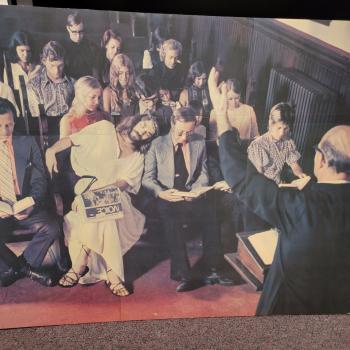On pages 795-804, Tom begins to make his case that the discussion of God’s righteousness needs to be had in the context of God’s covenant faithfulness, as the two are intertwined. He is well aware that we have difficulties doing justice to the dikaio- word group in English, as it has various nuances that the words righteous/righteousness/justice do not convey in English. In this section Tom draws on his earlier book on Justification. It is also in this context that we begin to see the real difficulties of trying to link the dikaio- words simply with what God has promised to do for and with his covenant people. How so? Rom. 1.18-32 is not about vindicating or even judging God’s covenant people. It’s about judgment on those with whom God had no such special covenant relationship. Obviously while there is a sense of vindication or even covenant faithfulness involved when we hear about Yahweh doing right by his promises and people in Is. 40-66, this can’t be the full scope of what Paul means by the term since Rom. 1.16-17 is clearly linked to Rom. 1.18-32, as Tom says. The ‘wrath’ side of righteousness revealed and carried out on the ungodly who are quite specifically not God’s covenant people, has nothing to do with a covenant with Abraham or Moses. One might argue it has to do with the original covenant with Adam… but the problem with that argument is that covenant is not part of the discussion in the Adamic portions of Genesis, or elsewhere. And while we are at it, Christ is said to come as the eschatological Adam, not the eschatological Abraham. In other words– the love, justice, salvation of God extends beyond the concept of covenant faithfulness or something owed to or vindicating of one’s already extant covenant people.
Tom gives a definition of covenant at the outset of this discussion “When… I refer to covenant and describe Paul’s theology in those terms, I refer to the theme which so strongly emphasized in Gen. 15,17 and Exodus 2,3,and 6 draws together Abraham as the divine answer to the problem of Adam, the promise about seed, and land, and the exodus as the way by which Abraham’s family would journey to that inheritance. When, in this context, we see Paul addressing the question of human sin, and like 4 Ezra, tracing this problem back all the way to Adam, we should not be surprised, if he draws on this same tradition of the divine covenant. I cannot stress too strongly…that within this confluence of themes, covenant and salvation belong tightly together the latter as the goal of the former, the former as the means of the latter.” (p. 795).
How this helps us understand salvation for the non-covenantal people, the very ones Paul’s mission focuses on, is not made clear at this juncture. It becomes even more problematic when Paul tells us in Rom. 11 that in the end, non-Christian Jews will be included in the final form of God’s people by being regrafted into the people, not on the basis of God’s faithfulness to the covenant with Jews, but rather on the same basis of pure mercy, by grace through faith in the Messiah Jesus when he returns at the eschaton. That is, on the same basis as which the non-covenantal Gentiles got into God’s people in the first place– by grace through faith in Jesus, and quite specifically without God being obligated by some covenant to permit this or make this possible.
Tom delineates three basic nuances of the diakio- word group. Dikaiosune has as a basic meaning ‘right behavior’. There is a second more forensic sense in which a judge must ‘do right’ to uphold the law and vindicate those who have been wronged, showing no favoritism, in particular to the more privileged of society. The person so vindicated is shown to be ‘in the right’ or as in the case of Judah and Tamar, she ‘has been justified rather than me’ (Gen. 38.26). When a court declares someone ‘in the right’ (in this particular matter), it is a legal judgment, not a statement that the person is inherently a righteous person. It is a status conferred by the court. Notice however that in the case of a legal judgment of ‘declared to be in the right in regard to previous conduct’ is a very different matter than for a person ‘to be set right’ even though they are a sinner. Thirdly, there is the sense of God vindicating his people as he has promised in the covenant to do, and here there is a conjunction of covenant faithfulness, God doing right, doing what he promised, and ‘righteousness’. This involves God’s restorative justice and covenant faithfulness. The ‘righteousness of God’ is the concept that links these two ideas together, in Tom’s view.
Thus this last sense of the dikaio- word group is used to explain both why God sent his own people into exile (they had sinned and God had to judge their sin) and why God, keeping his covenant promises forgave them and brought them back from exile as well (p. 802). The problem really comes when definition number 3 of this word group is said to be the one which Paul is operating with for example in Romans when he talks about the righteousness of God. This might explain the theme ‘to the Jew first’ but it cannot explain what Paul goes on to say about the salvation about the non-Jews, and indeed what he says about the salvation of Jews temporarily broken off from the people of God in Rom. 11. Tom must be allowed to have his own say— here is his last definitional word:
“when a first century writer, speaking of God’s providential salvation in line with his covenant with Abraham refers to God’s dikaiosune, he is speaking a) of an attribute of God himself and b) more specifically of the attribute of covenant faithfulness [hence the very title of these two tomes by Tom]. Not just the divine mercy (which would act even on behalf of the undeserving); not just the divine salvation (which would consist simply of YHWH’s rescuing of his people, without explanation); not even his ‘steadfast love’, though that would be closer. The divine covenant faithfulness brings all these and more together.” (p. 804).


















